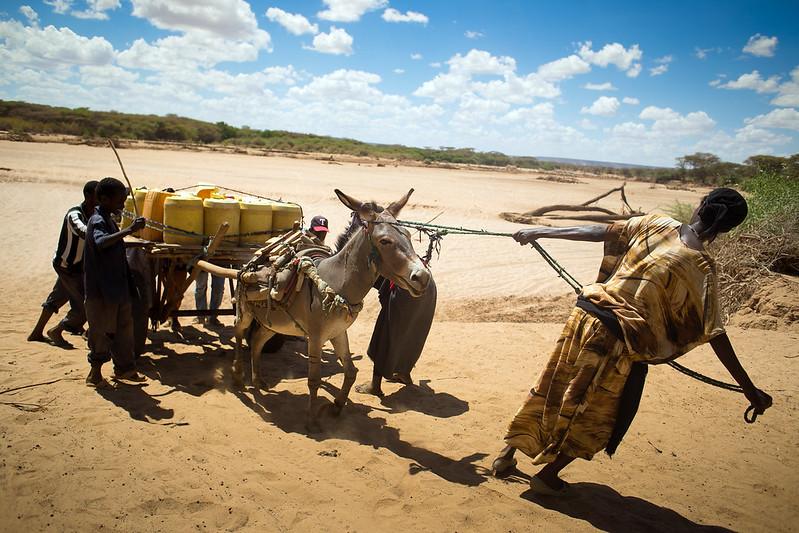Blog
Living with certainty: pastoralists grapple with drought in Horn of Africa
Pastoralists in the Horn of Africa respond well to different kinds of uncertainty. While this drought’s outcomes remain uncertain, it’s clear the months ahead will be difficult for the majority.
Around 20 million pastoralists in the Horn of Africa have experienced three poor/ failed rains and forecasts for the spring rains of 2022 are mixed. Experience tells us the surviving such a drought ahead of rebuilding of flocks and herds in the post-drought phase will be a daunting time: little or no milk for pastoral women and children or income from livestock sales, and inflated grain prices.
A decade earlier, international La Niña alerts issued in July 2010 were followed by Ethiopia’s National Meteorological Agency (NMA) September forecasts that the autumn and 2011 spring rains would be below normal or fail in the country’s southern pastoral areas. The forecasts were accurate. Drought conditions deepened through the summer of 2011. The pastoral areas of neighbouring Kenya, Somalia, and north-east Uganda were similarly affected.
The severity of the drought and associated impacts attracted international media attention and humanitarian organisations dispatched ‘surge teams’ to Nairobi, Kenya. For some involved, this was their first visit to the region and to a slow-onset drought disaster as they arrived from the 2010 Haiti earthquake disaster. In September 2011 a Heads of State Summit on the Horn of Africa Crisis pledged around US$2.8 billion to build resilience and end drought disasters. The 2011 autumn rains broke the drought and the recovery started. The following year, the Intergovernmental Authority on Development (IGAD) launched its Drought Disaster Resilience Sustainability Initiative (IDDRSI) platform.
Ten years on
A decade later, international La Niña alerts were issued in August 2020 the autumn rains were again below normal/failed across the same pastoral areas. The spring rains of 2021 also failed, and millions of pastoralists across the region again faced drought impacts through the summer. Unusually, international La Niña alerts were again issued in the late summer of 2021 and again the autumn rains have either been well below normal or failed.
A mid-November report suggested that seasonal rainfall was the lowest on record since 1981, concerns have also been raised that the 2022 spring rains will again be below normal or fail. This contrasts with the two-season 2010-2011 Horn of Africa drought. Now the pastoral areas of the Horn of Africa face a rare four-season drought that may well continue through to October 2022. As a result, the lives and livelihoods of millions of people living in these arid and semi-arid lands are threatened including, those in market towns if, as expected, deep boreholes also fail.
Lessons learned from the past
Learning lessons from the 2010-2011 drought emergency, national governments are taking the lead in current drought response and the deployment of emergency surge teams has so far been avoided. Somalia and Kenya have declared drought emergencies and are assisting drought-affected communities and together with Ethiopia, all are sending food and other assistance to their respective pastoral communities. A decade of investment in resilience building and social protection is also helping.
However, the severity impact of the drought has and will continue to deepen the result of other non-drought related hazards: locusts, the COVID-19 pandemic - including the reduced remittance flows - and consecutive restricted Hajj pilgrimages and associated lost opportunities to export livestock to Saudi Arabia for the pilgrims. The pandemic’s grip may also be re-tightening with the Omicron variant.
Livestock losses are already significant and will continue to increase through to the onset of the next rains. If the 2022 spring rains are poor/fail, livestock losses will be catastrophic. Furthermore, the implications will be huge as typically, it takes from 4-7 and 8-12 years to rebuild small ruminant flocks and herds of cattle and camels respectively, following a drought emergency in which around 50% of animals are lost.
Without support - such as assisted migration to non-drought affected areas, supplementary feed, and access to irrigated fodder - the forecast losses are higher than 50%. This means it will take longer to recover. Experience also suggests that wealthier pastoralists with more diverse livelihoods and extensive social networks, including relatives living in capital cities and overseas, will build back faster. Other already poorer pastoralists will probably fail to return to their former livelihood.
Urgent need for international support for pastoralists facing drought
It’s too late for a September 2021 Heads of State Summit on the (New) Horn of Africa Crisis. It’s however increasingly clear that for pastoralists in Somalia, Kenya, Ethiopia, and north-east Uganda to survive and bounce back from this drought emergency, that a drought summit and associated international donor pledges will be required.
For those operational humanitarian and development partners already working in the drought affected area, the primacy is to work collaboratively with drought-affected pastoral communities to support them achieve their priorities and approaches to protect their families and core-breeding animals. Such support is likely to be required through to 2027-2028 and therefore well into the recovery period. Anything less would serve only to support them part way through what seems certain to be a most difficult and distressing time ahead.

Drought in Kenya's Ewaso Ngiro river basin
Credit Image by Denis Onyodi / KRCS - CC BY-NC 2.0